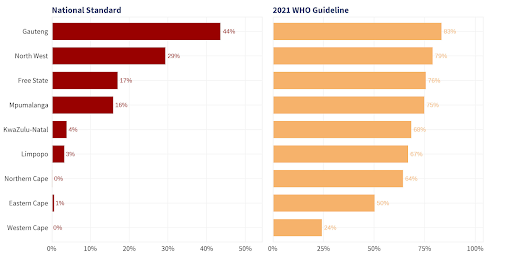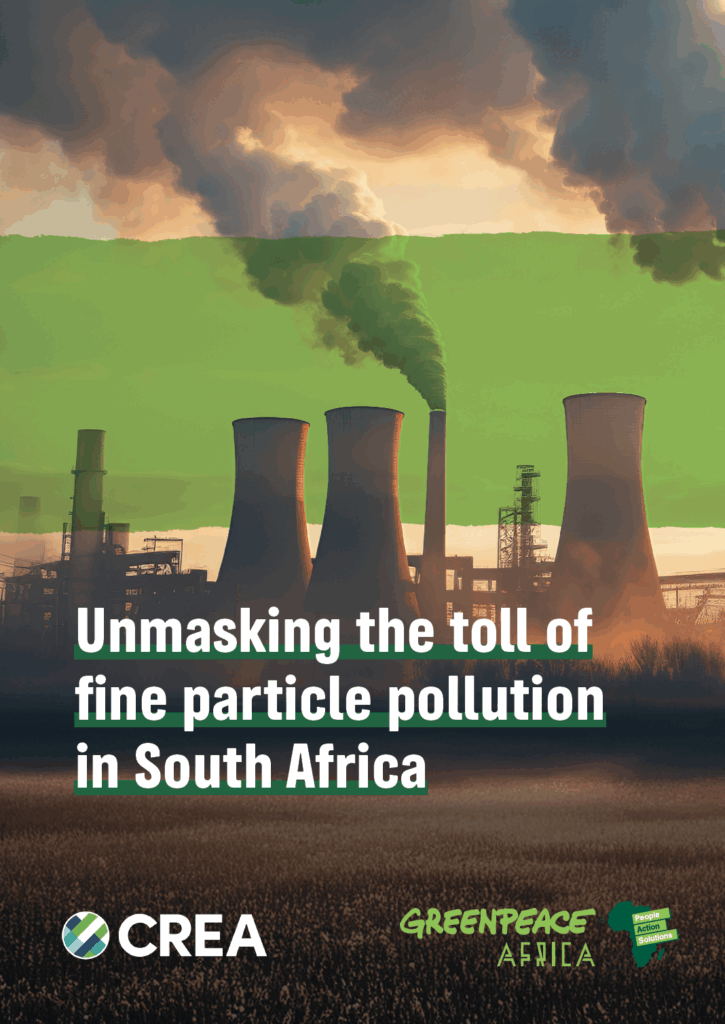In South Africa, large parts of the population breathe air containing pollutants at levels many times higher than the guidelines specified by the World Health Organisation (WHO). The country’s coal-based economy contributes significantly to high levels of air pollutants, including particulate matter (PM), sulfur dioxide (SO₂), and nitrogen oxides (NOX).
This report from CREA and Greenpeace Africa analyses the health and economic impacts of South Africa’s air pollution.
In 2023, PM2.5 exposure in South Africa led to an estimated 42,000 deaths, including over 1,200 deaths among children under five, 8% of all deaths estimated in the country in 2023.
Children are particularly vulnerable to the impacts of air pollution on respiratory health and make up more than half of asthma-related emergency room visits. PM2.5 also leads to an estimated 47,000 underweight births and 43,000 preterm births each year. Such outcomes not only affect infants’ immediate health but can also have long-term developmental and health implications, further stressing the healthcare system and future generations.
Exposure to PM2.5 also contributes significantly to chronic diseases and disabilities of the overall population. Annual exposure to PM2.5 is associated with 26,000 years lived with disability (YLDs) due to chronic obstructive pulmonary disease; 20,000 YLDs due to stroke; 64,000 YLDs due to diabetes; and 19,000 due to Alzheimer and other dementias.
The impact of air pollution extends beyond direct health outcomes, imposing a significant economic burden on workforce productivity. PM2.5 in South Africa is estimated to lead to 30 million days of work absences due to pollution-related health issues. These absences represent lost productivity, disrupted workflows, and reduced economic output across multiple sectors. Air pollution health costs total approximately USD 52 billion (R960 billion) annually. The majority of this cost is due to the loss of life, followed by preterm births. This equates to approximately 14% of South Africa’s GDP.
In 2023, there were an estimated 42,000 deaths in South Africa due to air pollution. If the country were to meet its national air quality standard, this number would fall to 33,000 deaths, representing a 22% reduction and 9,300 lives saved each year. Violations of the national PM2.5 standard are therefore responsible for approximately 9,300 premature deaths annually. If South Africa were to further achieve the WHO guideline, deaths would decrease dramatically to 12,000 — a 72% reduction compared to current levels and an equivalent of saving 30,000 lives each year.

by meeting the national ambient air quality standard
and the WHO guideline
The health and economic impacts of air pollution on South Africa are substantial. The government should impose health impact penalties or introduce a ‘polluter-pays levy’ on large industrial emitters and coal-fired power plants. These must be accompanied by requirements for polluting industries to publish emissions data in real-time and publish regular reports on emissions and compliance.
Exemptions and delays to compliance with South Africa’s minimum emission standards (MES) and national ambient air quality standards (NAAQS) that are granted to polluting industries also must be ended urgently. These extensions perpetually weaken pollution regulations with devastating impacts on the South African population.
| Methodology PM2.5 exposure Human exposure to PM2.5 is estimated using the dataset of van Donkelaar et al. (2021) and Hammer et al. (2023), version V5.GL.05.02. The dataset provides estimates of annual ground-level PM2.5 by combining Aerosol Optical Depth (AOD) retrievals, the GEOS-Chem chemical transport model (http://geos-chem.org), and global ground-based observations. Health impact assessment Based on the spatial distributions of the PM2.5 simulated exposure map, we then calculated the corresponding public health impacts between 1 January 2023 to 31 December 2023. CREA’s health impact assessment (HIA) framework builds on earlier work (Myllyvirta, 2020) but incorporates important methodological updates. Compared to the original approach, we now use integrated exposure response (IER) functions from the upcoming GBD 2023 study (IHME, 2025) instead of the Global Exposure Mortality Model (GEMM), and we have added dementia as a new health endpoint. The framework continues to include a comprehensive set of health outcomes, selected to avoid overlap and to enable robust economic valuation. Find the full methodology in the report. |
